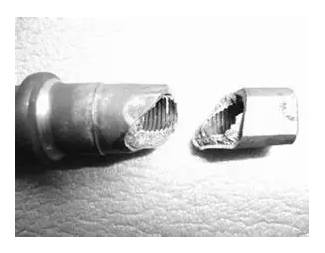The fatigue strength of bolts has always been a problem that has been paid attention to. There are data indicating that the failure of bolts is mostly caused by fatigue damage, and there are almost no signs of bolts in fatigue failure, so major accidents can easily occur when fatigue damage occurs. Heat treatment can optimize the performance of the fastener material and increase its fatigue strength. It is more important to improve the fatigue strength of the bolt material by heat treatment for the higher and higher use requirements of high-strength bolts. Keywords: material fatigue crack initiation The place where the fatigue crack first starts is called the fatigue source. The fatigue source is sensitive to the microstructure of the bolt and can initiate fatigue cracks at a small scale. Generally, within 3 to 5 grain sizes, the surface quality of the bolt is the main problem. The source of fatigue, most of the fatigue begins at the surface of the bolt or the subsurface. There are a large number of dislocations inside the crystal of the bolt material and some alloying elements or impurities, and the difference in grain boundary strength, these factors may lead to fatigue crack initiation. Studies have shown that the location of fatigue cracks is: grain boundaries, surface inclusions or second phase particles, voids, these locations are related to the complex and variable microstructure of the material. If the microstructure can be improved after heat treatment, the fatigue strength of the bolt material can be improved to some extent. Key words: decarburization effect on fatigue strength Decarburization of the bolt surface reduces the surface hardness and wear resistance of the bolt after quenching and significantly reduces the fatigue strength of the bolt. The GB/T3098.1 standard has a decarburization test for bolt performance and specifies the maximum decarburization depth. A large amount of literature indicates that due to improper heat treatment, the surface of the bolt is decarburized and the surface quality is degraded, so that the fatigue strength is lowered. When analyzing the cause of the failure of the high-strength bolt of the 42CrMoA wind turbine, it was found that the heading bar was at the junction because of the decarburization layer. Fe3C can react with O2, H2O and H2 at high temperature to reduce the Fe3C inside the bolt material, thereby increasing the ferrite phase of the bolt material, reducing the strength of the bolt material and easily causing microcracks. The heating temperature is controlled during the heat treatment, and it is necessary to use a controlled atmosphere to protect the heating. Key words: heat treatment, fatigue strength In the analysis of the fatigue strength of the bolt, it was found that the improvement of the static load bearing capacity of the bolt can be achieved by increasing the hardness, and the improvement of the fatigue strength cannot be achieved by the method of increasing the hardness. Because the bolt has a notched stress, it will cause a large stress concentration, and the hardness of the sample without stress concentration can increase the fatigue strength. Hardness is an index to measure the hardness of a metal material. It is the ability of a material to resist the intrusion of a harder object. The hardness also reflects the strength and plasticity of the metal material. The stress concentration on the surface of the bolt will reduce the surface strength. When subjected to alternating dynamic loads, the process of micro-deformation and recovery will continue to occur at the stress concentration of the notch, and the stress is much greater than that of the stress-free concentrated portion. Causes the generation of fatigue cracks. The fasteners are heat-treated and quenched to improve the microstructure, and have excellent comprehensive mechanical properties, which can improve the fatigue strength of the bolt material, reasonably control the grain size to ensure low-temperature impact work, and also obtain high impact toughness. Reasonable heat treatment to refine grains and shorten the grain boundary distance can prevent the occurrence of fatigue cracks. If there is a certain amount of whiskers or second particles inside the material, these added phases can prevent the resident slip to some extent. The slip of the belt prevents the initiation and propagation of microcracks. Keywords: conclusion Fatigue cracks always occur in the weakest part of the material. Bolts are prone to cracks due to surface or subsurface defects. The interior of the material is prone to traps, grain boundaries, surface inclusions or second phase particles and voids. These locations are prone to stress concentrations. The heat treatment has a great influence on the fatigue strength of the bolt material. During the heat treatment process, the heat treatment process should be specifically determined according to the bolt performance. The initial fatigue crack is caused by stress concentration caused by the microstructure defects of the bolt material. Heat treatment is a method to optimize the fastener structure, which can improve the fatigue performance of the bolt material to a certain extent and improve the life of the product. In the long run, it can save resources and conform to sustainable development strategies. relevant information: Improve the anti-fatigue strength of bolt joints---fastener expertise (easy to ask questions 8) Check the fatigue strength of bolts---fastener expertise (easy to ask questions 15) Wedge Flow Meter,Venturi Flow Meter,Wet Gas Venturi Meter,Horizontal Venturi Meter Jingsu Huaerwei Science and Technology Group Co.,Ltd , https://www.hewflowmeter.com